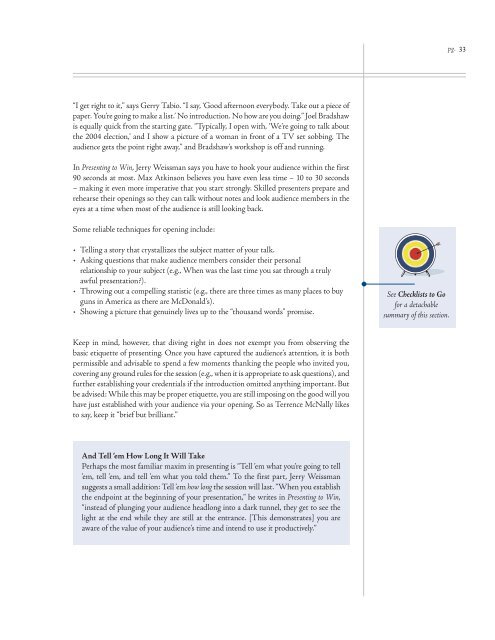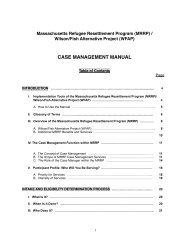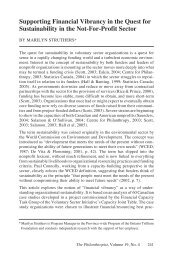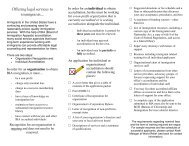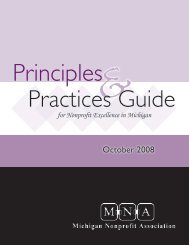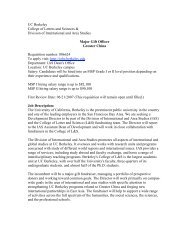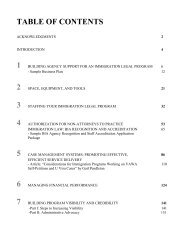Why Bad Presentations Happen to Good Causes - The Goodman ...
Why Bad Presentations Happen to Good Causes - The Goodman ...
Why Bad Presentations Happen to Good Causes - The Goodman ...
Create successful ePaper yourself
Turn your PDF publications into a flip-book with our unique Google optimized e-Paper software.
“I get right <strong>to</strong> it,” says Gerry Tabio. “I say, ‘<strong>Good</strong> afternoon everybody. Take out a piece of<br />
paper. You’re going <strong>to</strong> make a list.’ No introduction. No how are you doing.” Joel Bradshaw<br />
is equally quick from the starting gate. “Typically, I open with, ‘We’re going <strong>to</strong> talk about<br />
the 2004 election,’ and I show a picture of a woman in front of a TV set sobbing. <strong>The</strong><br />
audience gets the point right away,” and Bradshaw’s workshop is off and running.<br />
In Presenting <strong>to</strong> Win, Jerry Weissman says you have <strong>to</strong> hook your audience within the first<br />
90 seconds at most. Max Atkinson believes you have even less time – 10 <strong>to</strong> 30 seconds<br />
– making it even more imperative that you start strongly. Skilled presenters prepare and<br />
rehearse their openings so they can talk without notes and look audience members in the<br />
eyes at a time when most of the audience is still looking back.<br />
Some reliable techniques for opening include:<br />
• Telling a s<strong>to</strong>ry that crystallizes the subject matter of your talk.<br />
• Asking questions that make audience members consider their personal<br />
relationship <strong>to</strong> your subject (e.g., When was the last time you sat through a truly<br />
awful presentation?).<br />
• Throwing out a compelling statistic (e.g., there are three times as many places <strong>to</strong> buy<br />
guns in America as there are McDonald’s).<br />
• Showing a picture that genuinely lives up <strong>to</strong> the “thousand words” promise.<br />
Keep in mind, however, that diving right in does not exempt you from observing the<br />
basic etiquette of presenting. Once you have captured the audience’s attention, it is both<br />
permissible and advisable <strong>to</strong> spend a few moments thanking the people who invited you,<br />
covering any ground rules for the session (e.g., when it is appropriate <strong>to</strong> ask questions), and<br />
further establishing your credentials if the introduction omitted anything important. But<br />
be advised: While this may be proper etiquette, you are still imposing on the good will you<br />
have just established with your audience via your opening. So as Terrence McNally likes<br />
<strong>to</strong> say, keep it “brief but brilliant.”<br />
And Tell ’em How Long It Will Take<br />
Perhaps the most familiar maxim in presenting is “Tell ’em what you’re going <strong>to</strong> tell<br />
’em, tell ’em, and tell ’em what you <strong>to</strong>ld them.” To the first part, Jerry Weissman<br />
suggests a small addition: Tell ’em how long the session will last. “When you establish<br />
the endpoint at the beginning of your presentation,” he writes in Presenting <strong>to</strong> Win,<br />
“instead of plunging your audience headlong in<strong>to</strong> a dark tunnel, they get <strong>to</strong> see the<br />
light at the end while they are still at the entrance. [This demonstrates] you are<br />
aware of the value of your audience’s time and intend <strong>to</strong> use it productively.”<br />
See Checklists <strong>to</strong> Go<br />
for a detachable<br />
summary of this section.<br />
pg. 33


